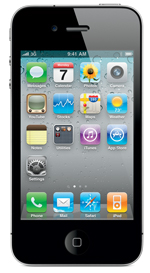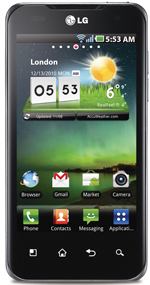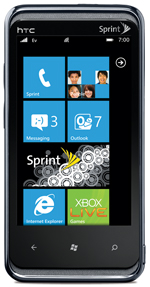Redmond Roundup
The Smartphone OSes Compared: Apple iOS vs. Google Android vs. Microsoft's Windows Phone 7
Apple, Google and Microsoft are battling for market share in the smartphone OS space. While Apple and Google have more popular but similar offerings, Microsoft Windows Phone 7 represents a new vision in the market.
Close your eyes and imagine that it's 2006. You're holding a smartphone. Have a picture in your head? Odds are it looks something like a Palm device or a BlackBerry of some type -- or perhaps it's running Windows CE. It has some form of e-mail connectivity, but it either requires you to contort your mind to type on it (using a phone keyboard with a predictive or "multitap" approach) or it has a very petite physical keyboard that's hard to type on for long.
It probably also has a Web browser, but one that either displays only text or requires Web sites to re-author content using the Wireless Application Protocol, to the extent that you may not be able to access the entire site, or access it at all. Third-party applications for it are probably limited, and, importantly, either a hand-held stylus or a trackball or tracking device is used for all navigation for the phone and applications.
Whether you're a fan of Apple Inc. and the iPhone or not, it's hard to ignore the fact that Apple changed the meaning of the word smartphone, and in doing so fired a shot heard 'round the world that made Apple and Google Inc. competitors -- and made Microsoft the underdog in mobile devices. Smartphones are now gesture-based, often don't have physical keyboards at all, have nearly full-featured Web browsers, and have changed the way millions of us interact with e-mail.
This roundup looks at the capabilities of the three main smartphone contenders: Apple iOS, Google Android and Windows Phone 7. Some might elect to only compare Android and iOS, but when you consider the clean-slate UI approach Microsoft has taken with Windows Phone 7, along with the company's recent partnership with Nokia, it's important to understand the differences and the similarities of all three.
To try and elaborate on limits of the software rather than the hardware, this article will compare iOS 4.3, the latest version of Android (2.3) designed for use on phones, and the only version of Windows Phone 7 released to date, with its initial update.
 |
| Apple iPhone 4 |
Apple iOS 4.3
Apple's simple, icon-driven UI is intended to be easy for anyone to become familiar with. But short of customizing a background bitmap, rearranging icons or placing icons in "folders" on one of 11 different "home screens," the iPhone is limited in how it can be customized. The iPhone's lack of customizability and necessity for every app to be screened by Apple is a positive feature for those looking for a device that's easy to learn and use, but can be a limitation for those who want to run absolutely any application or customize the device more deeply.
Though iOS is derived from the Mac OS X, it's extremely constrained in terms of functionality and developer programmability. An external keyboard can be used over Bluetooth, but iPhones don't have any built-in physical keyboard, and users navigate the interface using one or more fingers to scroll, pinch, stretch or flick, as they do in Android and Windows Phone 7.
With iOS, every application that runs on the device must be approved by Apple -- or, if you're an ad hoc developer building apps for your organization, applications can be distributed to up to 100 iPhones within your organization. For commercial applications, this means meeting certain (largely undocumented) rules about development tools, design or Apple competitive limitations, as well as Apple's own (unpublicized) guidelines for decency.
Until recently, all non-system apps were killed when not in the foreground of the device, and started again when in focus. This was done largely to maximize battery life. Like any device, more applications left open and running on the device means more rapid depletion of the battery. Outside of applications built into the phone itself that can take advantage of deeper undocumented programming interfaces, multitasking on the iPhone is still limited.
Initially Apple only allowed "push notifications," where an application could place an overlay with a counter or a (single) system-modal dialog based upon messages sent over the network to the phone. Today, multitasking on the iPhone works with three specific task types: Voice-over-IP (VoIP) applications (such as Skype), background audio (such as Pandora) and background location (such as Google Latitude). Applications can't perform any background work other than these tasks, and can't interact with hardware outside of programming interfaces that Apple allows. Applications that don't use these multitasking interfaces can still take advantage of notifications, can stay open in the background until they have finished tasks (such as sending a network message), and are generally suspended in memory rather than killed -- resulting in a significantly faster application resume than in earlier versions of iOS.
Key criticisms often leveraged at iOS generally involve a desire to run applications that do things outside the bounds of what Apple allows; a need for deeper customization of the OS, such as login screens; and the lack of deep voice interaction with the device (as Android now delivers). The limitation of running only Apple-approved applications is a detriment for those wanting to run apps Apple might not approve. However, it's also a significant benefit, as this means malware must find its way through the approval process, through a purchase and onto the phone. This is a difficult, but not impossible, proposition. In addition, customers wanting devices that can "do more" than an iPhone -- such as include Near-Field Communication, a physical keyboard or a larger screen -- must live with the hardware that Apple elects to design and build on Apple's timeline.
Apple has built features and apps into the iPhone to take advantage of its market share in music and media, including iTunes Home Sharing, which enables an iOS device to play back music or movies on a PC or Mac, and a remote-control app for controlling iTunes on a Mac or PC as well as with the Apple TV 2.0 device.
To date, iPhones have generally delivered about a three-year anticipated lifespan. The original iPhone was not upgradeable to iOS 4, and the iPhone 3G (second generation), while upgradeable, did not include multitasking enhancements and will likely not be upgradeable to new iOS versions for long. Apple has introduced a new version of the iPhone every year and will most likely do so again this year, probably late in the first half or early in the second half of the year.
 |
| LG Optimus 2X |
Google Android 2.3
Google Android is the result of technology Google acquired in 2005. It uses a Linux-based kernel and is an open source project. Android 1.0, shipped in 2008, was the first released version of Android.
Much of the Android OS experience can be customized, including login screens. While the fact that Android is open source and deeply customizable appeals to many, it has especially appealed to device manufacturers (and even more to telecommunications providers) that can deliver devices that Google doesn't have to approve. Manufacturers and telco providers can also customize the experience and add third-party applications to the phone.
The default UI of Android is somewhat similar to iOS, but has its own feel and is different in many ways. For example, the entire world of iOS lives within a 4x5 inch grid of application icons, while Android isn't as tightly constrained. Criticized by some as lacking the "polish" of iOS, the Android UI is often customized by providers -- though not always to the benefit of the end user. Google doesn't charge anyone to redistribute Android, and in fact pays royalties back due to the search and other traffic returned to it (resulting in ads) through the use of the devices.
Unlike with iOS, there's no approval process for applications. You can run any app you want on your Android device, from any number of marketplaces. While this is convenient for power users, it has already been used to push malware onto devices. Just like Apple, Google can remotely remove high-risk applications from devices, and has done this before. As of this writing, Amazon.com Inc. has just launched its own Android app store, with a key difference being that the applications will be vetted before becoming available for purchase or download. Because Android doesn't have application-publishing limits, it can be used more broadly within an organization where developing an internal app is desired but more than 100 devices are required.
Android provides for voice-based search (voice parsing and query are handled by Google servers), turn-by-turn navigation (not available on the iPhone, though Google provides the iPhone navigation data) and an overall more "Google-integrated" experience. For consumers who are fans of Google services, open source or Android, or for users who desire device hardware features, software features or applications that aren't available with Apple, Android provides a compelling offering -- resulting in devices that sell in larger volume than iOS devices.
Android applications can run in the background, but can be killed as needed by the OS. More importantly, Android provides mechanisms for running applications in the background that can be used by application developers in more powerful ways than in iOS, though poorly authored applications that always run unneeded services in the background and don't clean up after themselves can result in poor battery life. Unlike iOS, where applications are suspended, killed or limited to the range of background tasks iOS supports, Android will keep running applications until the resources they're consuming are needed.
Some key downsides of Android include the fact that updates must come from manufacturers or be manually hacked into place by technically adept owners. Many Android devices have unfortunately not been easily upgradeable from the version of Android they originally shipped with, resulting in unpatched security vulnerabilities and missed features. Google recently broke out separate components of Android to ensure that many built-in apps on Android itself can be updated without the OS, though this doesn't help device owners who haven't been able to update to the latest version of Android, in which this feature was released.
Arguably, the inability to update some devices could mean that Android devices could have a more limited lifecycle than iOS devices -- but only if the owner has a desire to run the absolutely latest version of the OS and the manufacturer doesn't elect to support it.
Another criticism is "sticky" applications installed by the provider that can't be removed from the device, by design; Windows Mobile was at times criticized for this same attribute in the past.
 |
| HTC Arrive |
Microsoft Windows Phone 7
The newest platform on the block, Windows Phone 7, offers a new UI. Underneath is a Windows Mobile/Windows CE infrastructure, redesigned to handle the update process and design constraints of Windows Mobile.
Windows Phone 7 is shipped on devices that must meet Microsoft design guidelines. While these guidelines aren't locked down to any explicit device design, there are specific requirements Microsoft enforces around the types and locations of buttons and logos, and there are rules requiring the single-screen resolution supported by Windows Phone 7. Also different is that OEMs pay Microsoft a royalty to ship Windows Phone 7.
Most notable to an end user, though, is the UI of Windows Phone 7. Rather than icons, Windows Phone 7 uses a start page with tiles that can indicate status -- number of e-mails, new Facebook updates and so on -- at a glance and enable an easy launch of the related application. Once launched from tiles or the list of applications, non-game applications appear quite visibly different from the other platforms in their design, which uses a side-scrolling design metaphor intended to organize information into unique views or tasks on individual pages.
As of March, Microsoft had released an update enabling clipboard support within Windows Phone 7 and providing some additional fixes, including improvements to app resume speeds. Windows Phone 7 doesn't yet include any multitasking support for applications outside of those in the OS itself. Similar to iOS, applications must be approved by Microsoft before they can be offered for download or purchase. Microsoft does not yet offer an ad hoc deployment model for applications.
|
Apple iPhone iOS |
Google Android |
Microsoft Windows Phone 7 |
| Hardware |
| Devices |
Designed and manufactured by Apple |
Designed and manufactured by OEM |
Designed and manufactured by OEM to Microsoft guidelines |
| Physical Keyboard |
No |
Depends on device |
Depends on device |
| Rear-Facing Camera |
Yes |
Yes |
Yes |
| Front-Facing Camera |
Yes (beginning with iPhone 4) |
Depends on device |
No |
| Device Resolution |
960x640
(iPhone 4), 480x320
(iPhone 3GS) |
Depends on device |
800x480 |
| Video Recording |
Yes |
Yes |
Yes |
| Video Chat |
Yes (beginning with iPhone 4, WiFi only) |
Depends on device (not WiFi only) |
No |
| Memory |
512MB (iPhone 4), 256MB (iPhone 3GS) |
Depends on device, most have 512MB currently |
Depends on device, most have 512MB currently |
| UI |
Apple design, constrained |
Google provided, many customized by OEM/Telco |
Microsoft design, constrained |
| WiFi |
Yes |
Yes |
Yes |
| GSM |
Yes (not on Verizon CDMA iPhone 4) |
Yes (depends on device) |
Yes |
| CDMA |
Yes (only on Verizon CDMA iPhone 4) |
Yes (depends on device) |
Expected in the first half of 2011 |
| Near-Field Communications (NFC) |
No |
Yes (depends on device) |
No |
| Additional Networks Supported |
No |
Yes |
Yes (no devices use them yet, though) |
| Software |
| Current OS Version |
4.3.1 |
2.3.3 |
7.0 |
| OS Kernel |
OS X derived (iOS) |
Linux derived (Android) |
Windows Mobile derived (Windows CE) |
| Update Process |
Issued by Apple, applied by user |
Issued by phone manufacturer, applied by user |
Issued by Microsoft, approved by telco, applied by user |
| Updates Applied |
Using synchronization application tool on computer |
Over-the-air |
Using synchronization application tool on computer |
| Multitasking |
Limited (beginning with iPhone 3GS) |
Yes, multiple types |
No |
| Clipboard Support |
Yes |
Yes |
Yes, as of first update from Microsoft |
| Third-Party Applications |
Yes, vetted by Apple |
Yes, not vetted by Google |
Yes, vetted by Microsoft |
| Application Store |
Apple only |
Several |
Microsoft only |
| Applications Available |
Approximately 370,000 |
Approximately 90,000 |
Approximately 9,000 |
| Ad Hoc (Internal) App Distribution |
Yes, but only up to 100 devices |
Yes |
No |
| Application Control |
Yes, Apple infrastructure |
No, though Google can, and has, removed rogue apps remotely |
Yes, Microsoft infrastructure |
| Built-in Music/Media Store |
iTunes Store |
None currently |
Zune Marketplace |
| Adobe Flash Support |
No |
In beta testing |
No |
| Microsoft Silverlight Support |
No |
No |
No |
| HTML5 Support in Browser |
Yes |
Yes |
No |
| Microsoft Office Document Support |
Read-only, thirdparty solutions available |
No, third-party solutions available |
Yes |
| Microsoft SharePoint Support |
No, thirdparty solutions available |
No, third-party solutions available |
Yes |
| Microsoft Exchange Support |
Yes |
Yes |
Yes |
| Device Synchronization |
Using iTunes from one Windows PC or Mac and MobileMe $99/year) |
Over-the-air or third-party applications |
Using Zune software from one Windows PC or Mac |
|
Windows Phone 7 offers limited user-customization options in this first version, though that's likely to change in the future. Microsoft has presented a very different vision for smartphones than have Apple and Google, and while it faces a race from behind to catch up with the mindshare of Apple and the market share of Android, it offers a unique design that's likely to appeal to users who are fans of Microsoft, or who are looking to get the benefits of a smartphone designed with a new focus on the ease of information consumption.
Making a Decision
With a commitment that's usually two years with a discount, acquiring a smartphone you'll use and enjoy is an important decision -- you don't want to waste money on a device that won't work for you or will frustrate you. Smartphones today have evolved to be as much about the software and how you use it as they were in 2006 about the hardware and the limited software provided in the device itself.